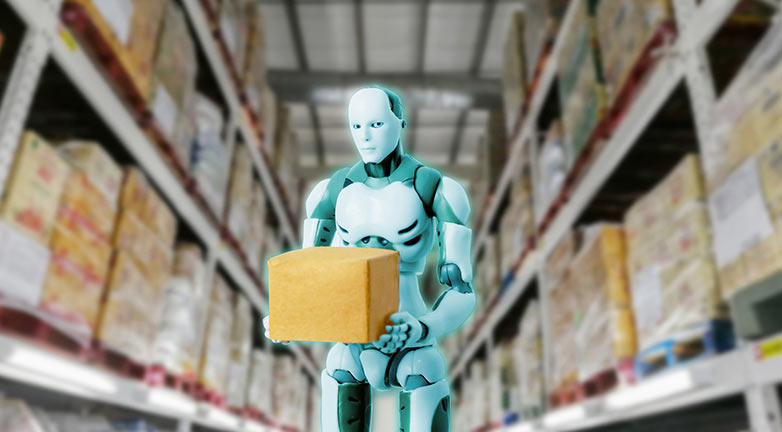ASCM Insights

Use Artificial Intelligence to Improve Reverse Logistics
By Shafiq Jadallah
Many executives have administrative assistants who schedule their meetings, manage their calendars and keep them on task. This frees up the executive to focus on building relationships, come up with big picture ideas and run the company. What if you could hire an administrative assistant to manage your company’s reverse-logistics operations? And what if that assistant was a robot?
Brick-and-mortar retailers are struggling to keep up with online stores because there’s so much overhead associated with a physical store, including employees. Many processes are manual, and technology isn’t integrated as deeply as it should be. This means there are numerous opportunities for brick-and-mortar stores to reduce employee efforts and save money by streamlining and automating processes using artificial intelligence (AI) and predictive analytics.
Predictive analytics is the use of data, statistical algorithms and machine-learning techniques to identify the likelihood of future outcomes based on historical data. Essentially, computers can monitor efforts and processes over time to find patterns and trends and then use those patterns to predict what will happen in the future.
Business owners can then look at those predictions and take action to alter the outcome. For instance, some organizations use predictive analytics to determine whether or not a customer will renew a yearly subscription based on his or her past behavior. If a customer is flagged as someone who won’t likely renew the subscription, sales and marketing teams can double down on efforts to change the customer’s mind before a decision is made.
Many businesses rely on AI and predictive analytics to improve their service, streamline operations and predict customer churn so it can be stopped before it occurs. Stores are capturing and analyzing images of customers to determine the effectiveness of in-store advertisements. Grocers are using machine learning to analyze photos of perishable products to check product freshness and alert employees of products that need to be removed from the floor. Retailers use predictive analytics to determine the likelihood of repeat purchases based on past purchasing behavior.
Although predictive analytics is most often used to predict customer behavior, there are many opportunities to use predictive analytics to improve internal processes, including reverse-logistics operations.
Currently, most companies aren’t spending much time or many resources on their logistics operations. Carriers are called on an as-needed basis when someone from a third-party janitorial crew notes that a container, trailer or dock floor is full. The system is extremely reactive and often unreliable. Store owners don’t always receive confirmation that the pickup was scheduled, nor do they know when a carrier is coming to retrieve the overflowing trailer.
This is even more problematic because many nations are experiencing a transportation crisis. When there is a shortage of qualified workers and equipment, this causes delays in services increased transportation costs. Businesses face accessorial fees if carriers are left to wait at the loading dock, if last-minute pickups are scheduled or if a shipment isn’t ready at the scheduled time.
For this reason, it is essential to optimize dock time and scheduling in all areas of supply chain management. Machine learning and predictive analytics can be especially helpful here. At this point in time, some retailers have installed devices on their containers and trailers that capture pictures of the store’s waste and recycling materials. My company, Sustayn, has developed smarter recycling and waste management systems that incorporate machine learning to analyze the images and learn to distinguish between the various types, improving sorting efforts.
When combined with predictive analytics, these smart waste management systems have the potential to allow businesses to predict when a load will be ready and notify the carrier ahead of time, so a full trailer isn’t left sitting for any longer than necessary. It also guarantees that the load will be ready to go when the carrier arrives to pick it up. This model removes the need for a third-party janitorial crew to be involved. More predictable pickups can be scheduled weeks — not just days — in advance, eliminating the chances of overflow and last-minute requests. Rather than relying on a stressful, reactive process, business owners can take control and create reliable and consistent systems.
Not only would this process limit accessorial fees, but it decreases human efforts, thus cutting costs and reducing errors. The automated notifications also free up employee time by moving low-value work from a person to a machine. Shipments are only scheduled when needed, and the process becomes highly automated.
Companies that have incorporated predictive analytics into their reverse-logistics operations have seen an improvement in service levels with fewer phone calls and reported issues. They’ve also realized freight savings between 5% and 10% by reducing last-minute load requests.
Of course, this is just the tip of the iceberg. There are endless opportunities for predictive analytics and machine learning to be used in reverse-logistics settings. It has the power to streamline and improve transportation planning and help alleviate some of the stress caused by the limited resources of the transportation crisis.
Unlike an administrative assistant, predictive analytics may not be able to make sure your meetings don’t run late, but it can help schedule load pickups, streamline processes and keep your business moving forward, freeing you up to focus on the big picture.
Shafiq Jadallah is the vice president of supply chain and analytics at Avangard Innovative, a data-driven company leading the way in increasing recycling and lowering landfill and waste costs.